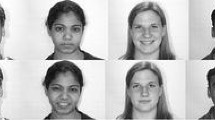Abstract
Previous research has demonstrated that women smile more frequently and more broadly than men (Abel 2002; LaFrance et al. 2003). However, little research has focused specifically on the age at which this gender difference first emerges, and even less on the ethnic differences in smiling. This study attempts to identify the age when gender differences in smiling emerge among European American and African American children and teenagers. Additionally, we looked at the level of diversity within each school and its relation to smiling behavior. In total, 18,201 yearbook photographs ranging from kindergarten through 12th grade from 17 schools in the state of Michigan were evaluated for smile type: full smile, partial smile or no smile. Results suggest that a significant gender difference in smiling emerges around age 11. In contrast to other studies (e.g., LaFrance et al. 2003) and our own expectations, differences in smiling were found to be larger between African American boys and girls than between European American boys and girls. In addition, we found that African American girls’ smiling behavior did not differ as a function of school diversity while African American boys from predominantly African American schools displayed less smiling compared to those from mixed or predominantly European-American schools. This study provides insight into the emergence and progression of gender differences in smiling and indicates that gender as well as ethnicity and ethnic diversity are influential factors in smiling behavior.


Similar content being viewed by others
References
Abel, M. H. (2002). An empirical reflection on the smile. Mellen studies in psychology (Vol. 4). Lewiston: Edwin Mellen Press.
Bem, S. L. (1981). Gender schema theory: A cognitive account of sex typing. Psychological Review, 88, 354–364. doi:10.1037/0033-295X.88.4.354.
Blakemore, J. E. O. (2003). Children's beliefs about violating gender norms: Boys shouldn't look like girls, and girls shouldn't act like boys. Sex Roles, 48, 411–419. doi:10.1023/A:1023574427720.
Block, J. H. (1976). Issues, problems, and pitfalls in assessing sex differences: A critical review of the psychology of sex differences. Merrill-Palmer Quarterly, 22, 283–308.
Brennan-Parks, K., Goddard, M., Wilson, A. E., & Kinnear, L. (1991). Sex differences in smiling as measured in a picture taking task. Sex Roles, 24, 375–382. doi:10.1007/BF00288310.
Carlson, M. (2008). I'd rather go along and be considered a man: Masculinity and bystander intervention. The Journal of Men's Studies, 16, 3–17. doi:10.3149/jms.1601.3.
Cohen, J. (1977). Statistical power analysis for the behavioral sciences. New York: Academic.
DeSantis, M., Mohan, P. J., & Steinhorst, R. K. (2005). Smiling in photographs: Childhood similarities between sexes become differences constant in adulthood. Psychological Reports, 97, 651–665. doi:10.2466/PR0.97.6.651-665.
Dodd, D. K., Russel, B. L., & Jenkins, C. (1999). Smiling in school yearbook photos: Gender differences from kindergarten to adulthood. Psychological Record, 49, 543–554.
Durik, A. M., Hyde, J. S., Marks, A. C., Roy, A. L., Anaya, D., & Schultz, G. (2006). Ethnicity and gender stereotypes of emotion. Sex Roles, 54, 429–445. doi:10.1007/s11199-006-9020-4.
Edelman, M. W. (1988). An advocacy agenda for black families and children. Thousand Oaks: Sage Publications, Inc.
Ellis, L. (2006). Gender differences in smiling: An evolutionary neuroandrogenic theory. Physiology & Behavior, 88, 303–308. doi:10.1016/j.physbeh.2006.03.034.
Fredrickson, B. L., & Roberts, T. (1997). Objectification theory: Toward understanding women's lived experiences and mental health risks. Psychology of Women Quarterly, 21, 173–206. doi:10.1111/j.1471-6402.1997.tb00108.x.
Galambos, N. L., Almeida, D. M., & Petersen, A. C. (1990). Masculinity, femininity, and sex role attitudes in early adolescence: Exploring gender intensification. Child Development, 61, 1905–1914. doi:10.1111/j.1467-8624.1990.tb03574.x.
Glick, P. C. (1988). Demographic pictures of Black families. In H. P. McAdoo (Ed.), Black families (pp. 111–132). Thousand Oaks: Sage Publications, Inc.
Guerra, N. G., Huesmann, L. R., Tolan, P. H., Van Acker, R., & Eron, L. D. (1995). Stressful events and individual beliefs as correlates of economic disadvantage and aggression among urban children. Journal of Consulting and Clinical Psychology, 63, 518–528. doi:10.1037/0022-006X.63.4.518.
Hall, J. A., Horgan, T. G., & Carter, J. D. (2002). Assigned and felt status in relation to observer-coded and participant-reported smiling. Journal of Nonverbal Behavior, 26, 63–81. doi:10.1023/A:1015683720462.
LaFrance, M., & Hecht, M. (2000). Gender and smiling: A meta-analysis. In A. Fischer (Ed.), Gender and emotion: Social psychological perspectives (pp. 118–142). Cambridge: Cambridge University Press.
LaFrance, M., Hecht, M., & Paluck, E. (2003). The Contingent Smile: A meta-analysis of sex differences in smiling. Psychological Bulletin, 129, 305–334. doi:10.1037/0033-2909 129.2.305.
Matsumoto, D. (1993). Ethnic differences in affect intensity, emotion judgments, display rule attitudes, and self-reported emotional expression in an American sample. Motivation and Emotion, 17, 107–123. doi:10.1007/BF00995188.
Mills, J. (1984). Self-posed behaviors of females and males in photographs. Sex Roles, 10, 633–637. doi:10.1007/BF00287270.
Morse, C. (1982). College yearbook pictures: More females smile than males. Journal of Psychology, 110, 3–6.
Pompper, D. (2010). Masculinities, the metrosexual, and media images: Across dimensions of age and ethnicity. Sex Roles, 63, 682–696. doi:10.1007/s11199-010-9870-7.
Ragan, J. M. (1982). Gender displays in portrait photographs. Sex Roles, 8, 33–43. doi:10.1007/BF00287672.
Ricciardelli, R., Clow, K. A., & White, P. (2010). Investigating hegemonic masculinity: Portrayals of masculinity in men’s lifestyle magazines. Sex Roles, 63, 64–78. doi:10.1007/s11199-010-9764-8.
Rohlinger, D. A. (2002). Eroticizing men: Cultural influences on advertising and male objectification. Sex Roles, 46, 61–74. doi:10.1023/A:1016575909173.
Sargent, P. (2005). The gendering of men in early childhood education. Sex Roles, 52, 251–259. doi:10.1007/s11199-005-1300-x.
Steele, C. M. (1997). A threat in the air: How stereotypes shape intellectual identity and performance. American Psychologist, 52, 613–629. doi:10.1037/0003-066X.52.6.613.
Wisdom, J. P., Rees, A. M., Riley, K. J., & Weis, T. R. (2007). Adolescents' perceptions of the gendered context of depression: "tough" boys and objectified girls. Journal of Mental Health Counseling, 29, 144–162.
Author information
Authors and Affiliations
Corresponding author
Rights and permissions
About this article
Cite this article
Wondergem, T.R., Friedlmeier, M. Gender and Ethnic Differences in Smiling: A Yearbook Photographs Analysis from Kindergarten Through 12th Grade. Sex Roles 67, 403–411 (2012). https://doi.org/10.1007/s11199-012-0158-y
Published:
Issue Date:
DOI: https://doi.org/10.1007/s11199-012-0158-y




